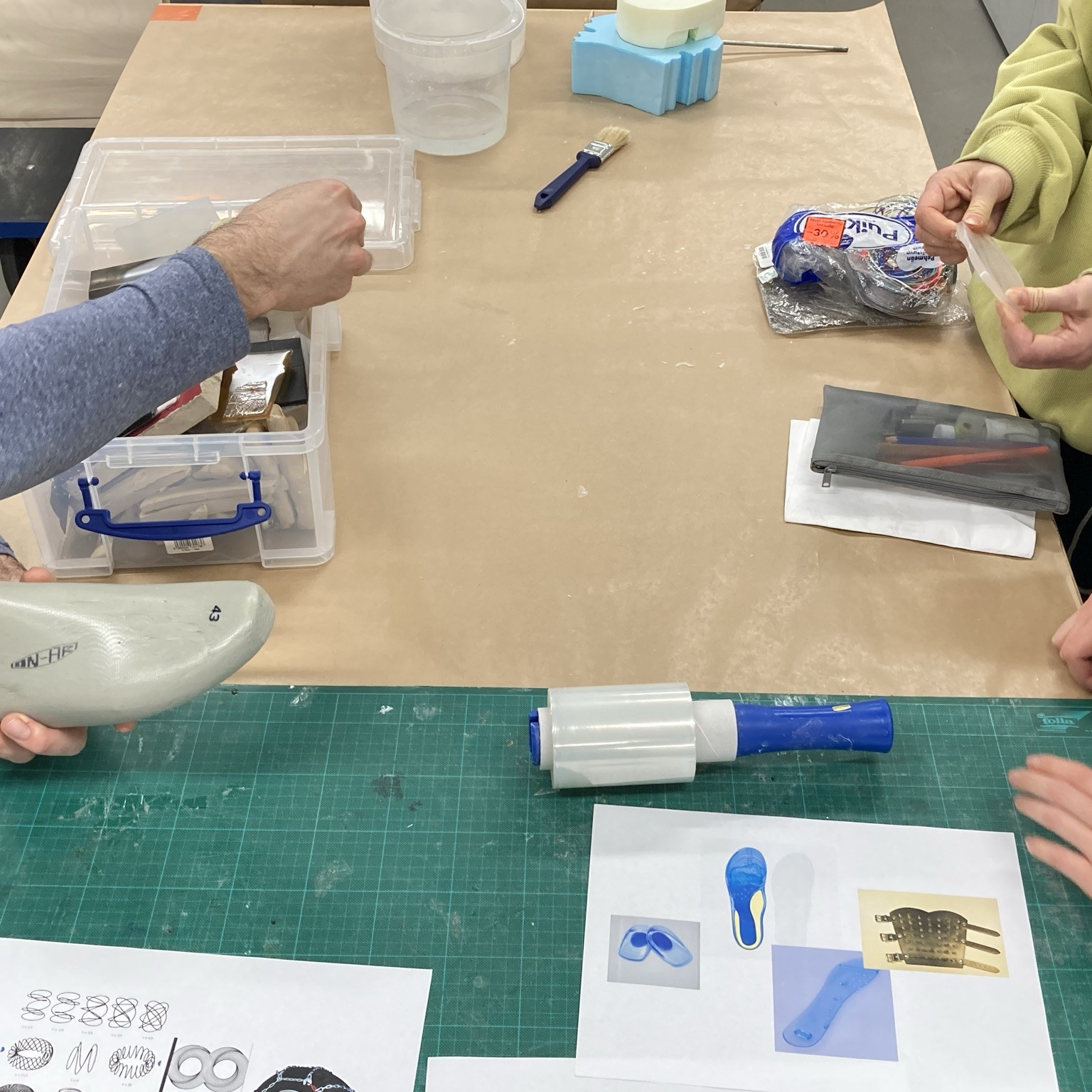From not yet knowing to achieving directionality
On the roles of materiality in multi-sited, interdisciplinary studio settings
DOI:
https://doi.org/10.7577/formakademisk.5389Emneord (Nøkkelord):
Materials, interdisciplinary collaboration, ideation, interaction, studio teachingSammendrag
This paper investigates the active role of materials in shaping ideation processes during interdisciplinary studio-based collaborations. Using ethnographic data collected from a graduate-level course conducted across multiple studio settings, we analysed how materiality facilitates interactions between students and studio instructors meeting for the first time when creative ideas are not yet fully formed and knowledge of unfamiliar materials is not yet embodied. The findings elucidate how certain materials are central to (1) demonstrating, (2) understanding, (3) sharing, (4) explaining, (5) generating and (6) challenging aspects related to ideation processes within such interactions. We conclude this work by emphasising the need for further research that focuses on material mediation in the context of student–instructor relationships.
Referanser
Cennamo, K., & Brandt, C. (2012). The right kind of telling: Knowledge-building in the academic design studio. Educational Technology Research and Development, 60(5), 839–858. https://doi.org/10.1007/s11423-012-9254-5
Cho, J. Y., Cho, M.-H., & Kozinets, N. (2015). Does the medium matter in collaboration? Using visually supported collaboration technology in an interior design studio. International Journal of Technology and Design Education, 26(4), 567–586. https://doi.org/10.1007/s10798-015-9322-3
Cross, N. (2006). Designerly ways of knowing. Birkhäuser.
Braun, V., & Clarke, V. (2012). Thematic analysis. In H. Cooper, P. M. Camic, D. L. Long, A. T. Panter, D. Rindskopf, & K. J. Sher (Eds.), APA handbook of research methods in psychology, (Vol. 2. Research designs: Quantitative, qualitative, neuropsychological, and biological, pp. 57–71). American Psychological Association. https://doi.org/10.1037/13620-004
Groth, C. (2017). Making sense through hands: Design and craft practice analysed as embodied cognition [Doctoral dissertation, Aalto University]. Aaltodoc. https://aaltodoc.aalto.fi/handle/123456789/24839
Heiss, L. (2020). Iterative prototypes as “boundary objects”: Facilitating interdisciplinary collaboration of a modular hearing aid. Design Journal, 23(6), 865–83. https://doi.org/10.1080/14606925.2020.1824412
Jeong, H. (2013). Development of group understanding via the construction of physical and technological artifacts. In D. Suthers, K. Lund, C. Rosé, C. Teplovs, & N. Law, N. (Eds.), Productive multivocality in the analysis of group interactions. Computer-supported collaborative learning series, (vol. 15, pp. 331–351). Springer. https://doi.org/10.1007/978-1-4614-8960-3_18
Jonson, B, (2005). Design ideation: The conceptual sketch in the digital age. Design Studies, 26(6), 613–624. https://doi.org/10.1016/j.destud.2005.03.001
Lahti, H., Seitamaa-Hakkarainen, P., Kangas, K. Härkki, T., & Hakkarainen, K. (2016). Textile teacher students’ collaborative design processes in a design studio setting. Art, Design and Communication in Higher Education, 15(1), 35–54. https://doi.org/10.1386/adch.15.1.35_1
McMahon M., & Bhamra, T. (2016) Mapping the journey: Visualising collaborative experiences for sustainable design education. International Journal of Technology and Design Education, 27, 1–15. https://doi.org/10.1007/s10798-016-9365-0
Salolainen, M., Partanen, J., Moslemian, O., Suorlahti, E., Kiviluoma, P., & Niinimäki, K. (2017). Crossing over boundaries through experimental pedagogy. In A. L. Bang, M. Mikkelsen, & A. Flinck (Eds.), REDO: Cumulus Conference Proceedings (pp. 156-168). Cumulus Association.
Scharmer, C. O. (2000). Organizing around not-yet-embodied knowledge. In G. von Krogh, I. Nonaka, & T. Nishiguchi (Eds.), Knowledge creation: A source of value (pp.36-60). Palgrave Macmillan. https://doi.org/10.1007/978-1-349-62753-0_3
Schön, D. A. (1987). Educating the reflective practitioner: Toward a new design for teaching and learning in the professions. Jossey-Bass.
Sheridan, K., Zhang, X., & Konopasky, A. (2022). Strategic shifts: How studio teachers use direction and support to build learner agency in the figured world of visual art. Journal of the Learning Sciences, 31(1), 14–42. https://doi.org/10.1080/10508406.2021.1999817
Tanggaard, L. (2015). The socio-materiality of creativity: A case study of the creative processes in design. In V. P. Glaveanu, A. Gillespie, & J. Valsiner (Eds.), Rethinking creativity: Contributions from social and cultural psychology (pp. 110–124). Routledge.
Vega, L., Mäkelä, M., Chen, T., & Seitamaa-Hakkarainen, P. (2021). Moments of entanglement: Following the sociomaterial trajectories of an intersubjective studio practice. FormAkademisk, 14(2), 1–14. https://doi.org/10.7577/formakademisk.4191

Nedlastinger
Publisert
Hvordan referere
Utgave
Seksjon
Lisens
Opphavsrett 2023 Anniliina Omwami, Luis Vega, Varpu Mehto, Priska Falin, Pirita Seitamaa-Hakkarainen

Dette verket er lisensiert under Creative Commons Attribution-NoDerivatives 4.0 International License.
- Forfatteren(e) beholder sin opphavs- og kopieringsrett til eget manuskript, men gir tidsskriftet varig rett til 1) å fremføre manuskriptet for offentligheten i den opprinnelig publiserte digitale form, og 2) å registreres og siteres som første publisering av manuskriptet.
- Forfatteren må selv forvalte sine økonomiske kopieringsrettigheter overfor eventuell tredjepart.
- Tidsskriftet gir ingen økonomisk eller annen kompensasjon for innsendte bidrag, medmindre det er gjort særskilt avtale om dette med forfatteren(e).
- Tidsskriftet plikter å arkivere manuskriptet (inklusive metadata) i den opprinnelig publiserte digitale form, i minst ett dertil egnet åpent tilgjengelig langtidsarkiv for digitalt materiell, som for eksempel i de norske universitetenes institusjonsarkiv innen rammen av NORA-samarbeidet.
Verket vil bli publisert OpenAccess med en Creative Commons 4.0-lisens som tillater alle å lese, dele og tilpasse innholdet, også kommersielt, under lisensvilkårene:
Dette verket må tilskrives/ krediteres på riktig måte, en lenke må gis til CC-BY 4.0-lisensen, og endringer som er gjort må angis på en rimelig måte, men ikke på noen måte som antyder at lisensgiveren støtter deg eller din bruk.



